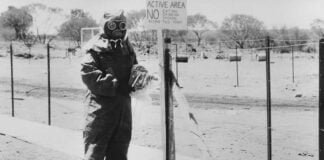There is growing anger in Japan at misinformation and efforts to downplay the seriousness of the nuclear crisis at Fukushima. A full month after the crisis began, authorities finally upgraded the disaster to a level seven emergency, the same ranking as the Chernobyl disaster. An official from TEPCO, the power company that owns the plants, told the media “The radiation leak has not stopped completely, and our concern is that it could eventually exceed Chernobyl.”
The same week Japanese authorities conceded that the evacuation area around the nuclear plants needed to be expanded from 20 kilometres to 30 kilometres.
According to Dr Rianne Teule, a Greenpeace radiation expert helping carry out independent monitoring of radiation levels:
“People in the area are exposed to the impacts of nuclear radiation often without being made aware by TEPCO or the authorities. We found radioactively contaminated vegetables with levels up to 75 times over the limits for consumption—even the growers have not even been warned against eating their crops!”
“Many of us feel betrayed,” said Tomoko Sato, who left her home in Minami-soma, a small town in the evacuation zone around the stricken Fukushima reactors, and who is now staying in a refugee centre in Akita prefecture, more than 200 kilometres north of the plant. “We were told again and again it was safe”.
“This is a man-made disaster,” said Ikuko Ishibashi, a farmer whose husband has remained on the farm to look after their livestock. “I want the reactors to be dismantled as soon as possible.”
Another evacuee said people were panicked by a lack of information and by the inadequate evacuation measures: “Because we did not have enough information, our anxiety increased”.
His family was ordered by local authorities to get “far away from the plant” without being told where to go.
At least 22 workers at the plants have been exposed to dangerously high levels of radiation.
Two workers at the Fukushima plant were rushed to hospital after their feet and ankles started burning as they waded through radioactive water in the number two reactor. Another worker fled when his equipment recorded radiation levels exceeding 1000 millisieverts. Most experts believe that even 100 millisieverts in a year can cause cancer.
Radioactive danger
The situation at the Fukushima plants is still extremely dangerous. TEPCO continues to admit further problems and details of serious contamination. In late April it admitted that spent fuel rods at a fourth reactor were releasing radioactivity 100,000 times higher than normal, indicating there had been an uncontrolled nuclear fission reaction.
It estimates it will take six to nine months before the sites can be brought to a safe condition. Workers will have to continue pouring water onto the fuel rods in an attempt to cool them and avoid nuclear meltdown for months more. About 10,000 tonnes of contaminated water from this cooling process have been simply dumped into the sea, and a further 60,000 tonnes of water also has to be disposed of.
Highly toxic plutonium has been detected in small amounts in soil surrounding the plant. Its release indicates one of the reactor containment cores has probably been breached.
TEPCO and the Japanese government have tried to play down the health risks posed by exposure to the radiation.
But there is an abundance of scientific research showing significant links between radiation exposure and cancers, Down’s syndrome, kidney and liver damage, and other serious diseases.
Even living near operational nuclear plants is linked to a rise in illness. Research in Scotland showed there was a large rise in incidences of leukaemia in children living near a nuclear reprocessing plant compared to children of the same age living in the area before the facility began operating. Similar findings have been shown in France and Germany.
Anger at the risks posed by nuclear power has been felt worldwide following the disaster at Fukushima. Across Germany 250,000 marched in a weekend of protest against the country’s 17 nuclear plants. At the end of March the first Green head of a state government was elected on the back of this wave of anger.
Demonstrations against the building of a huge six-reactor complex in India, billed as the biggest nuclear plant in the world, have drawn tens of thousands. Rallies have been held in Japan too, the largest of 15,000 in Tokyo.
The nuclear industry can never be safe. Fukushima shows why we need to shut down all nuclear power plants—and stop the mining and export of uranium from Australia that fuels them.





